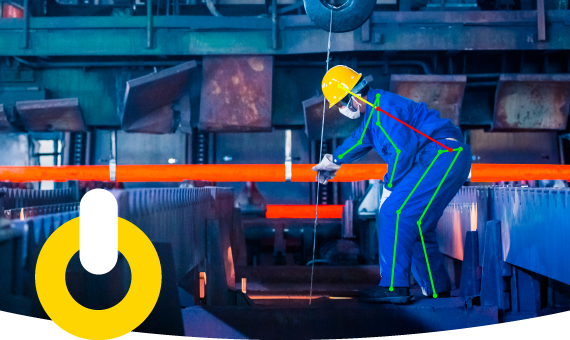The Future of Ergonomics: How AI is Transforming Workplace Safety


- 23.12.2023
- Ergonomics

In 1950, Britain officially adopted ‘ergonomics’ as a word.
It comes from Greek: ‘ergon’ means work, and ‘nomos’ means natural law.
Ergonomics is the science of optimizing interactions between workers and their work environments. Simply put, it’s about creating workspaces that suit worker capabilities and limitations.
The ultimate goal?
To enhance worker well-being, productivity, and safety.
The science of ergonomics blends anatomy, engineering, design, and psychology focusing on how workers interact with their working environments, tools, and tasks.
In any workplace setting, ergonomics ensures that tools, machinery, and workstations are custom-tailored for workers’ needs. Much like a tailor expertly tailors clothing, ergonomics focuses on customizing the workspace to reduce physical strain, prevent injuries, and enhance productivity.
Think of it as the science of arranging your environment to ensure you’re not just efficient but also physically and mentally comfortable.
Evolution of Ergonomics in the Workplace
In the past, workspaces often lacked ergonomic considerations. Think about workplaces with fixed machinery, inadequate tool designs, and minimal concern for workers’ physical well-being.
Today, ergonomics has significantly evolved to focus on the future of employee comfort. There’s a heightened focus on adapting machinery, tools, and even production lines to fit workers’ requirements, ensuring they’re safe, comfortable, and efficient.
AI and its Impact on Ergonomics
What is next for ergonomics?
AI-driven workplace ergonomics!
AI is changing how we approach workplace safety by using computer vision to analyze worker movements, postures, and environmental factors.
AI-driven ergonomics technology enables real-time assessments, allowing for proactive adjustments that reduce ergonomic risks and create safer, more comfortable workplaces.
Traditional Ergonomics vs. AI-Driven Ergonomics
Imagine making ergonomic changes by trial and error. That’s how it was done traditionally. People studied posture and comfort manually, relying on their own observations and feedback. It worked, but it took time and sometimes wasn’t as accurate.
Limitations of Traditional Approaches
Traditional ergonomics was good, but it wasn’t perfect. There were times when it missed small details that could make a big difference. Also, it often required a lot of manual effort and might not have catered to everyone’s unique needs.
Emergence of AI in Ergonomics
Picture having a super-smart friend helping you set up your workspace! AI in ergonomics is like that friend. It uses clever algorithms to understand what makes you comfortable and safe, doing it much faster and often more accurately than humans.
Advantages of AI-Driven Workplace Ergonomics
AI changes the game! It’s like having a genie granting ergonomic wishes. It predicts and adapts to your needs, ensuring personalized comfort. With AI-driven ergonomics, your workspace becomes a safety-centric haven tailored just for you.
The Role of AI in Proactive Issue Identification
AI is like a superhero when it comes to analyzing data. It can sift through enormous volumes of information swiftly, detecting patterns and trends that human eyes might miss. Imagine conducting ergonomics assessments, real-time posture detection using computer vision, and leveraging cameras for analyzing risk. It’s easier, faster, and importantly- it’s a lot more accurate!
Proactive Identification of Ergonomic Issues
AI is proactive; it predicts problems before they become issues. By analyzing posture, movement, and workplace setup, AI can identify potential ergonomic risks and suggest improvements to avoid discomfort or injury.
Data-Driven Precision in Issue Resolution
AI doesn’t just find problems; it solves them too! With data-backed insights, AI-driven workplace ergonomics solutions can recommend precise adjustments tailored to individual needs. It’s like having a personal ergonomics consultant available 24/7.
Real-world Example
Consider a scenario where AI detects a repetitive motion in material handling that could lead to discomfort and subsequent injury. It alerts the user and suggests modifications in real-time. This proactive approach helps prevent ergonomic issues before they arise.
Computer Vision Technology and AI in Ergonomics
Computer vision technology has made substantial strides in enhancing ergonomic practices by integrating advanced AI capabilities.
This technology acts as a 24/7 ergonomist, detecting potential postural and physical hazards, and fostering healthier work environments through proactive intervention.
Real-time Posture and Movement Monitoring
Computer vision cameras offer real-time analysis of posture and movement, allowing continuous assessments of ergonomic conditions.
Through precise monitoring, these systems instantly detect ergonomic risks, enabling swift corrective actions to enhance workplace safety and well-being.
Preventing Injuries and Promoting Healthy Practices
Real-time posture and movement monitoring through computer vision technology aids in identifying potential ergonomic hazards promptly. By providing immediate feedback and alerts for incorrect postures or movements, it helps prevent injuries.
Moreover, it promotes healthy practices by encouraging users to maintain proper ergonomics, reducing strain and fostering better workplace habits.
Data Analysis for Workplace Design and Improvement
Importance of Data in Ergonomics
Data in ergonomics plays a crucial role in Workplace Design and Improvement as it provides invaluable insights into employee behaviors, habits, and work patterns.
By collecting and analyzing this data, organizations can identify trends, understand ergonomic risks, and design workspaces tailored to meet employees’ needs. It enables informed decision-making, allowing for proactive adjustments that enhance comfort, reduce workplace injuries, and boost productivity.
Analyzing Trends and Patterns
Analyzing trends and patterns in ergonomics data offers a deeper understanding of how employees interact with their work environment.
It helps in identifying recurring issues or risks, recognizing common ergonomic challenges, and determining specific areas that require improvement.
By recognizing these patterns, organizations can proactively address concerns, implement targeted interventions, and create more effective ergonomic solutions tailored to their workforce needs.
Enhancing Workplace Design through Insights
Enhancing workplace design through insights gathered from trend analysis and pattern recognition allows organizations to tailor their environments for better ergonomics.
By harnessing these insights, businesses can redesign workspaces, rearrange equipment, introduce ergonomic furniture, or modify processes to optimize comfort, safety, and productivity. It ensures that the workplace is conducive to employee well-being, leading to higher satisfaction, reduced injuries, and increased efficiency.
Overcoming Challenges and Concerns
Addressing Privacy and Security Concerns
Safety experts understand the criticality of safeguarding employee privacy. Implementing advanced measures such as face blurring, background blurring, and encryption ensures the protection of sensitive data collected through AI-driven ergonomics.
Ensuring User Acceptance of AI Technologies
Gaining employee trust in AI-driven ergonomics is pivotal. Thorough training, transparent communication, and involving employees in the process enhance acceptance and engagement with privacy-protective AI technologies.
Regulatory Compliance in AI-Driven Ergonomics
Complying with stringent data protection regulations is a priority. Safety experts work diligently to align AI ergonomics practices with established guidelines, ensuring ethical data handling and legal compliance.
Future Trends in AI-Driven Ergonomics
As safety experts, understanding the evolution and future prospects of AI in ergonomics is vital. Here are some insights into upcoming trends shaping the landscape:
Predictions for the Next Decade
AI Advancements: Anticipate substantial advancements in AI algorithms, enabling more accurate posture analysis, movement tracking, and proactive risk identification in real-time.
Innovations in AI Technology for Ergonomics
The future of AI technology in ergonomics is expected to bring smarter tools that adapt better to individual needs.
We’ll likely see more advanced cameras, wearable devices, and AI-driven suggestions that can instantly help us improve our posture and stay healthier while working. This tech could give us tips in real-time, making it easier to avoid strain and work comfortably.
Benefits of AI in Ergonomics
Businesses and employees are expected to have many benefits from AI in ergonomics with proactive workplace safety, reduced risk of injuries, enhanced productivity, and increased comfort.
For businesses, this means lower healthcare costs, fewer work-related injuries, higher employee satisfaction, and improved efficiency. Employees can expect a safer work environment, less strain, better health, and increased job satisfaction.
Conclusion
AI is set to optimize ergonomics by offering real-time insights into workplace conditions, enabling proactive adjustments, and predicting potential hazards. AI shifts the paradigm from reactive safety measures to proactive identification and resolution of ergonomic issues, fostering a safer work environment.
AI’s transformative role will involve personalized workspace setups, continual monitoring, and instant feedback, fostering safer, more comfortable, and adaptive work environments. AI’s predictive capabilities will not only prevent injuries but also optimize employee well-being, ultimately enhancing workplace productivity and overall satisfaction. Embracing AI-driven workplace ergonomics signifies a commitment to prioritizing employee well-being, resulting in increased satisfaction and productivity.
To future-proof workplaces, businesses must embrace AI-driven ergonomics, incorporating these advancements into their safety strategies. Equipping safety experts with AI-driven ergonomic solutions builds a culture of safety, comfort, and efficiency in the workplace.
Knowella AI Inc. helps companies make data-informed operational decisions.
On Knowella platform, you’re be able to automate your health, safety, and quality-focused programs, processes, and workflows! Our people-centric and data-driven solutions boost frontline engagement and well-being, while helping companies save time and money.
- 23.12.2023